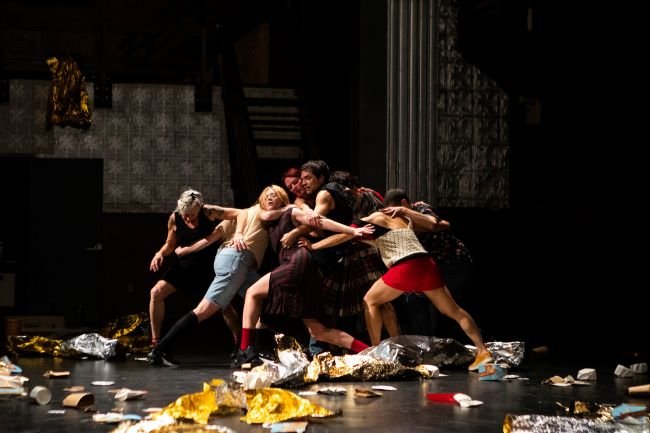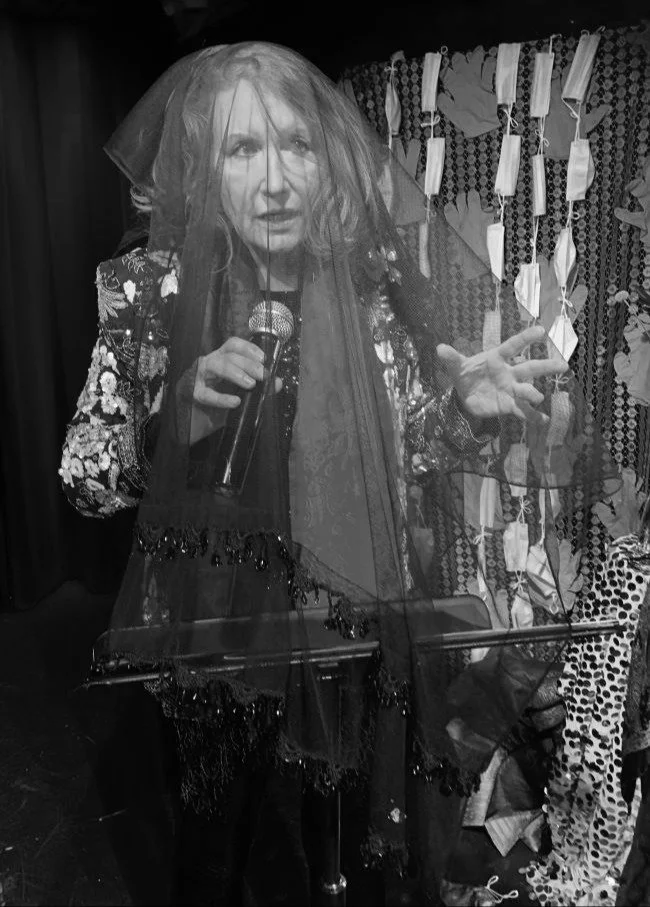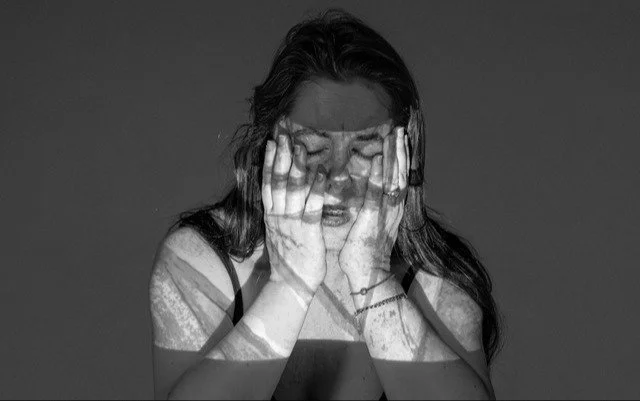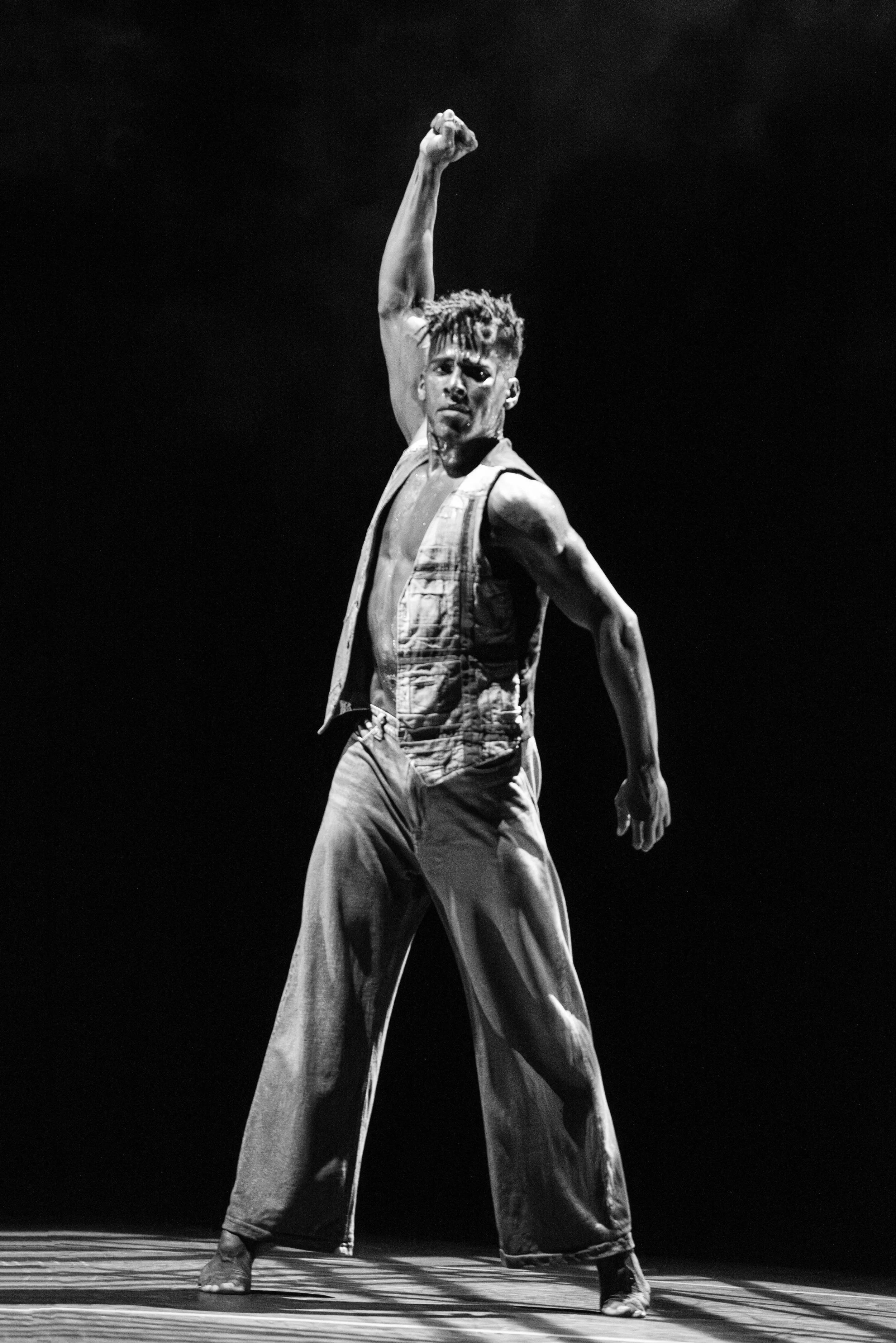ASHLEY CHEN'S choreographies of complexities
Ashley Chen, French choreographer, performer, and founder of Compagnie Kashyl, brought his dances and a film to LaMaMa, NYC, on two programs, November 30-December 10, 2023, as part of Villa Albertine’s 2023 Dance Season.
In his choreography, Chen explores individuality, anonymity, community, diversity, vulnerability, and reliance. He pushes himself and his performers to the point of exhaustion to expose the unprotected self.
A triptych of dances, Unisson, Rush, and Distances, asks the questions, “In what ways does a group invent itself through dance? How can movement become a tool to forge a sense of sharing and unity? What are the outer limits of each other’s personal space? At what point do we support one another when propelled by an incessant driving force?”
Two works-in-progress, TUMBLE, and OutSide Flow (film), along with choreographer Merce Cunningham’s Dime a Dance, presented as a special event on two performances, completed the program.
Interview by Catherine Tharin
Your LaMaMa, NYC, season was ambitious as you presented two large and extended group dances, two duets, and a film. How were you able to bring the dances to the U.S.? What are the primary motivations of these works?
I’ve always wanted to show the three pieces as a triptych in one program, but this involves a lot of performers who are all amazing and, therefore, in high demand. It is exciting but hard to show dances with a lot of dancers. Many had other commitments back in Europe. Therefore, one dance, Distances, was cast with NYU Tisch School of the Arts dancers plus three original Kashyl cast members. I haven’t presented the dances in a long time because Covid hit.
The triptych questions social behavior through the group, and through each other in the duet. There is the lack of tolerance in Unisson. As the dance proceeds, tolerance is achieved. In Rush there is the necessity in supporting each other to keep moving forward at a fast pace. In Distances there is the question of the need for personal space.
TUMBLE is a duet that I’m creating for myself and the cello player, Pierre Le Bourgeois. It is about the journey of artists. The film, OutSide Flow, is made with Peter Steven, my half-brother. We were residents of the Villa Albertine residency program in California and NYC, where the film was shot. It is inspired by the gestures of outdoor laborers. Dime a Dance was choreographed by Merce Cunningham in 1953. It’s a dance game party.
In all the work, I’m interested in the exchange between us. We laugh a lot. I’m interested in discovering other cultures. In France, the cultures are very separate.
Could you please explain the separateness of cultures you experience in France? Given this separateness, NYC seems a natural fit for you.
My mother is Scottish, and my father is half French and half Chinese, which explains my non-French name. I grew up in Normandy (France) in the 1980/90s. A multicultural upbringing, such as mine, wasn’t common back then. When I arrived in NYC in 2000 (to dance with the Merce Cunningham Dance Company), I was fascinated by NYC, a cultural hub, and thought that’s what makes this place special – the many cultures coexisting. The different cultures, each creating its own ecosystem, were an inspiration.
In what ways do your dances reflect your mixed heritage?
Diversity fascinates me. I like my pieces to create communities. I work a lot on energy - exertion is central to my work’s DNA. The exhaustion one experiences exposes the vulnerability of each and every one of us. I push the boundaries, and in doing so, individuality is exposed. When one is exhausted, one shows how one truly moves and comes to an essence of oneself. Tolerance of individuality hopefully follows.
Could you say more about what compelled you to create Unisson? What movement material was explored when choreographing the dance?
Unisson is a dance about tolerance. I started to think about it in 2015/16 when the political background was not great – Le Pen, Brexit, Trump. It was not so much about those in power but that the regular person didn’t want to share. I ask the question: “How important is a diverse community?” I make the same movement for all my dancers, but they dance the movement the way they can. They’re of different generations, younger and older (more experienced), and different cultures.
I was searching for a way for the group to invent itself through dance and, thus, attain togetherness. We studied social dances, created before phones!, that people enjoy together. We studied folk dances from Spain, line dancing from the States, Botswana traditional dances, Protestant Icelandic dances, and more. The dances are pan-cultural and linked to our world heritage, which is a rich heritage. I’m proud of those world dances. We took it all in, digested it, and made a social dance for today, dancing in the way you can or want to dance. Individuality and personality are explored.
I try to show tolerance (of the individual within the group). Over time, there have been shifts in the dancers' makeup – sometimes more men or women. The audience sees how much we enjoy performing this dance. (Cast: Compagnie Kashyl dancers Magali Caillet-Gajan, Ashley Chen, Peggy Grelat-Dupont, Mai Ishiwata, Theo Le Bruman, Lucius Romeo-Fromm and recent NYU graduates Camryn Tomaszewski and Salma Kiuhan)
Unisson - photos by Kristin Sollecito
It is apparent, from this viewer’s point of view, that your dancers, at ease with one another, implicitly trust the group. In what ways do you encourage openness in rehearsal?
I try to create a safe environment for people to show themselves. I try to be generous enough for people to feel safe. We work with improvisation, and I push the physicality. The musician, Le Bourgeois, and lighting designer, Eric Wurtz, are on stage, too, for all the dances. I like to show the group- the dancers- as we are. I like to show everything. The cues are live and in front of everyone.
The duet, Rush, is danced with Julien Monty, a close and trusted associate for 30 years. You appear to be racing to the ends of your lives. What are you saying about aging?
Rush is a dance I made with my best friend from high school. We were aging dancers, running nonstop for 40 minutes when we made Rush. Now, we’re four years older. We ask the questions, “How do we keep up while aging, and how do we finish the task by helping each other?” We’re never sure if we’re going to make it!
Rush - photos by Kristin Sollecito
What was the inspiration for Distances?
Ten years ago, I was on a hot subway in France, and it was packed. A guy who was taller than I sweated, and his sweat dripped on me. As a result, I asked myself, “To what extent can I narrow down my personal space to get home quicker?” This was the starting point of the process of Distances, a piece also inspired by anonymity and promiscuity in public spaces. This is why I cover the heads of the performers. By covering the faces, there is a great bodily presence that comes out. It allows each to move in weird ways.
At the beginning of the research period, the male and female dancers improvised back-and-forth movements, but sexual connotations were too present. Instead, I aimed to illustrate the significance of gaps between bodies and the ways the bodies expressed protective, aggressive, intrusive, and inviting states of being. Then, I tried an all-female cast and found the sisterhood energy fascinating.
The piece becomes meditative. It’s like a psychedelic subway trip that morphs constantly, creating a phantasmagorical entity formed by the whole group. Watching the piece, one can be inspired by current events. For instance, when we were making the dance, one dancer ended up kneeling on another dancer’s back. It was a week after the George Floyd incident. The kneeling was unexpected and really strong.
We premiered the piece during the pandemic. The audience thought I was talking about Covid. Now, the main references are war and migration, but you also witness beautiful things (fortunately!), such as children innocently playing, people falling in love, and protective parents. There is always something beautiful and always something tragic in the dance. (Cast: Kashyl members, Grelat-Dupont, Ishiwata, Caillet-Gajan; NYU Tisch School of the Arts students: Brooke Biafore, Louise Coleman, Remy Corbin, CVeleste Goldes, Jacqueline Lee, Lilly Lorber, Kaitlyn Posada, Ngozi Mokwunye, Emilia Pace, Elena Wrinkle Garcia)
Distances - photo by Bronwen Sharp
What did you learn from Merce that influenced your work?
As a performer, I like to jump on walls and roll on the floor. Merce’s work was all about the challenge. I pushed the limits when I was younger. I went straight to pure movement without struggle. My approach to his work was how do you organize the body to accomplish the task? How do you move into that shape? You create architecture with your body. You’re asked to go too fast, too slow, too far. The movement gets really wild. And you can’t hold it. There was an animalistic approach to the movement. Merce was very generous – if you fell, he might say, “I’m sorry, you tried, you’ll do better tomorrow.”
CATHERINE THARIN choreographs, curates, teaches, and writes. She danced in the Erick Hawkins Dance Company in the 1980s and '90s, was the Dance and Performance Curator at 92NY, NYC, for 15 years, and was a senior adjunct professor at Iona College, New Rochelle, NY, for 20 years. She writes dance reviews for The Dance Enthusiast and The Boston Globe, articles about dance for Side of Culture, and reports on dance for WAMC/Northeast Public Radio. She curated a 2024 dance season at Stissing Center, Pine Plains, NY. She continues to teach the Hawkins philosophy, technique, and repertory as an artist-in-residence. Her latest dance is a collaboration with jazz composer Joel Forrester and filmmaker Lora Robertson. Says Fjord Magazine of her work presented in November 2023: "gentle and precise movement contained to a small range, a good deal of floor work...cast a net of whimsical translucent sheen over it all. The evening was consistently charming, well-crafted and paced."











